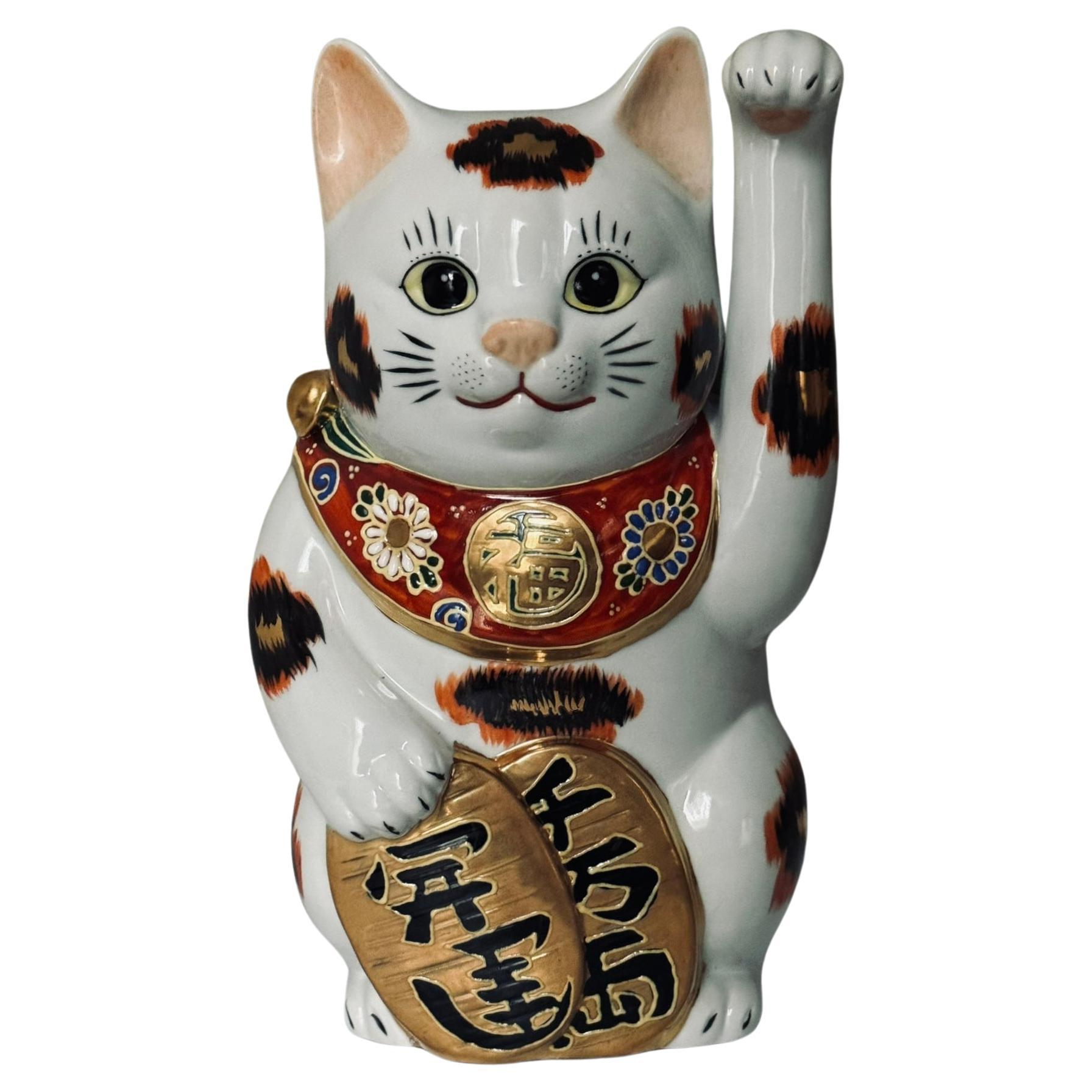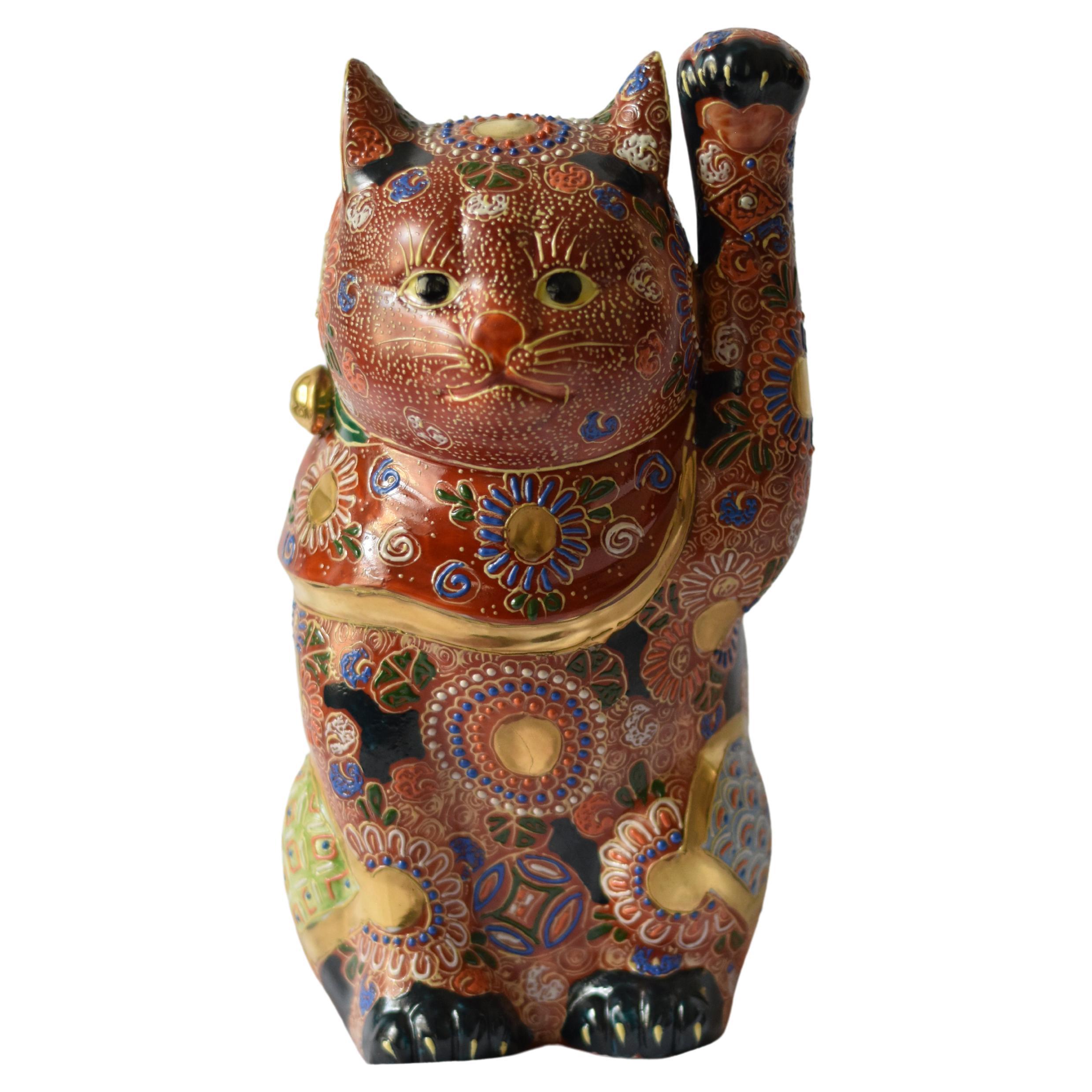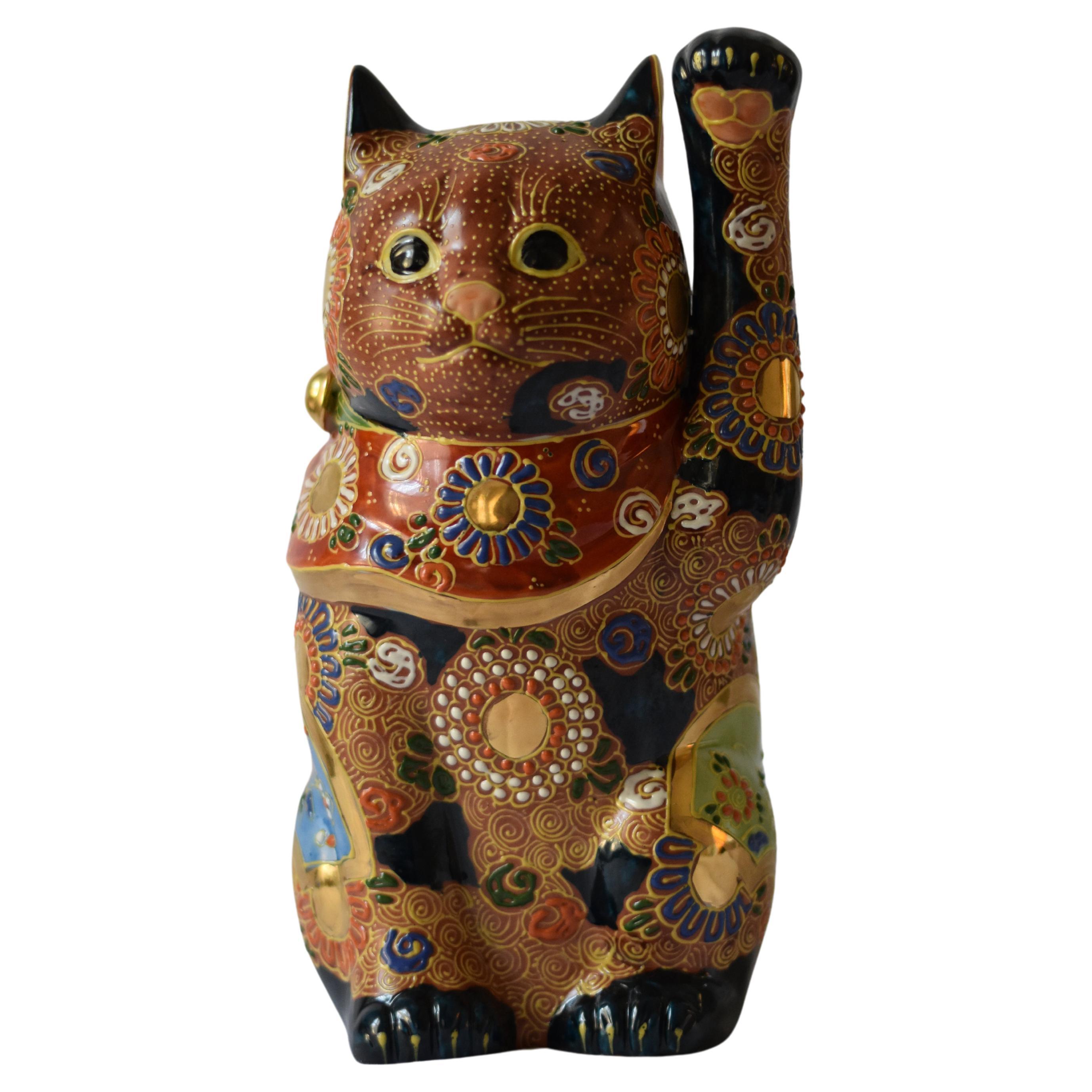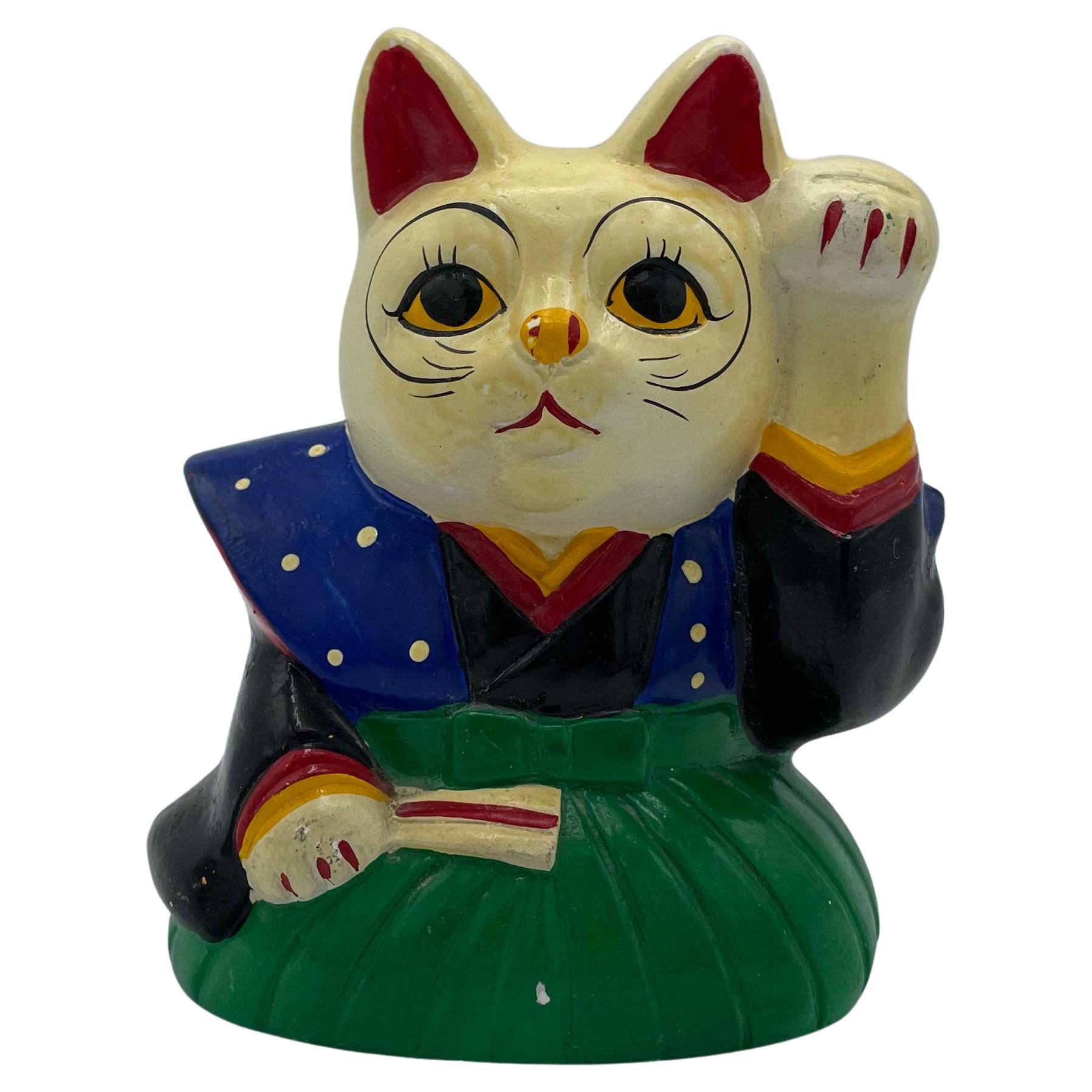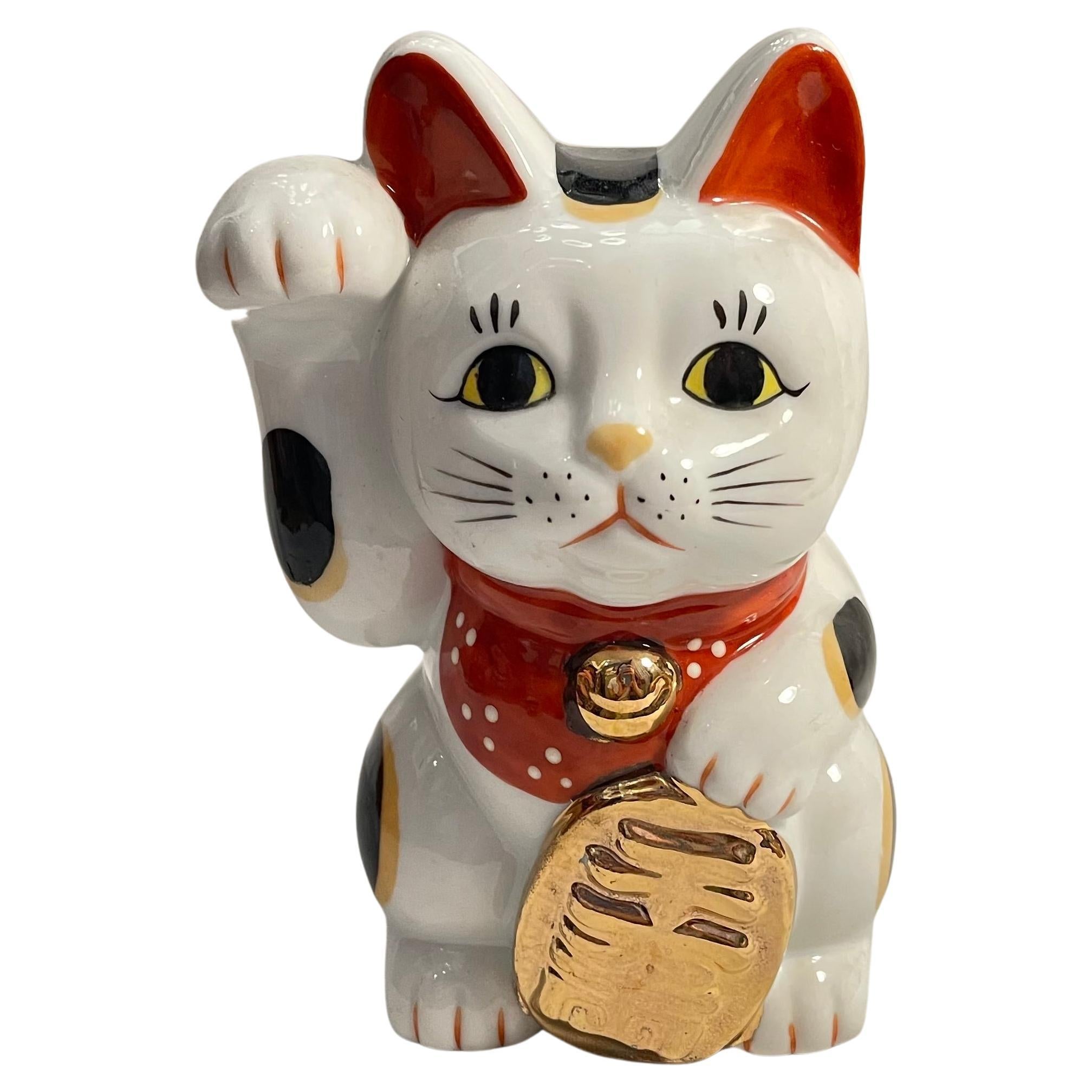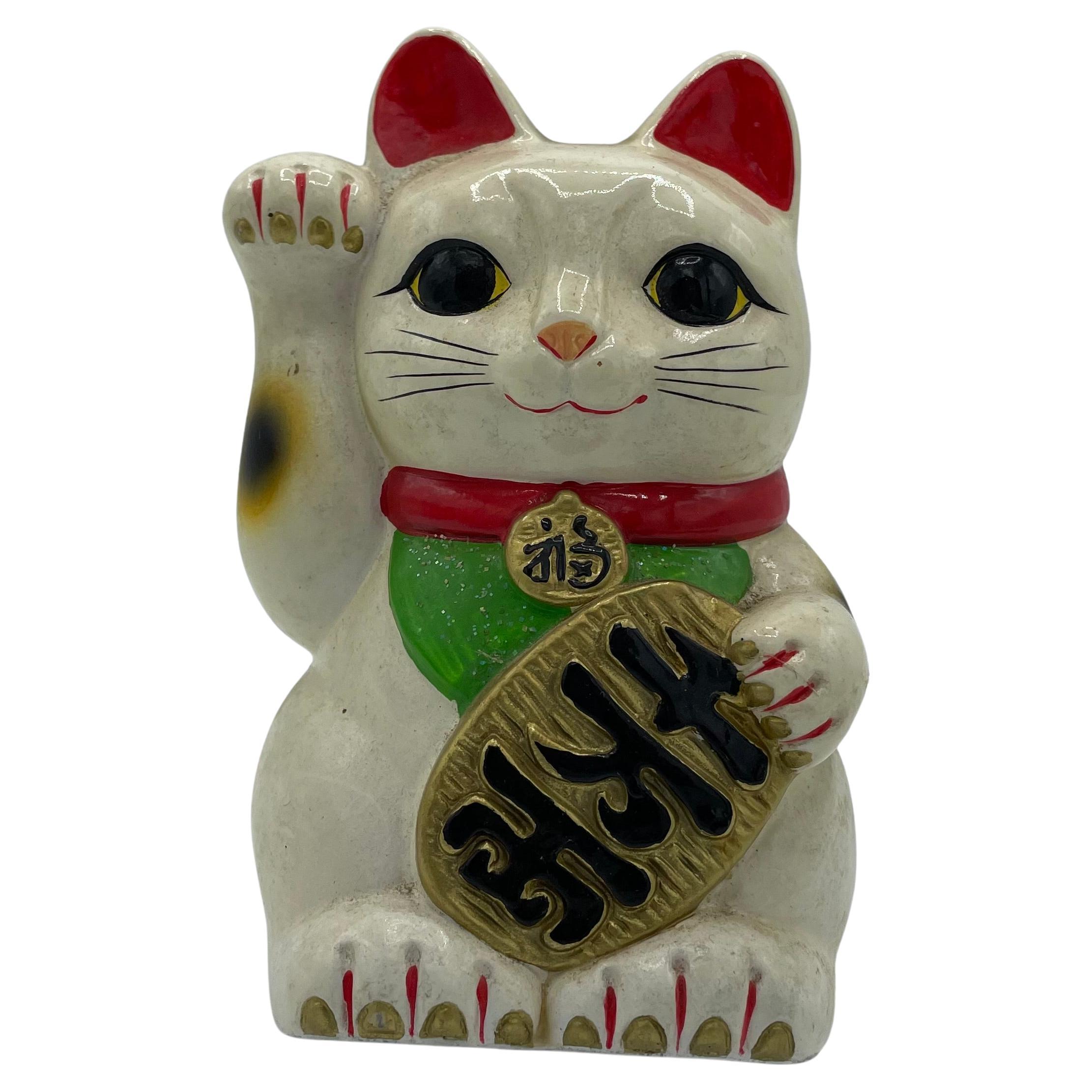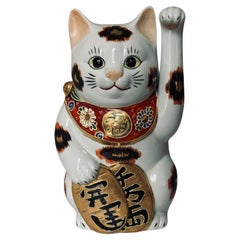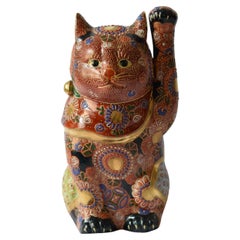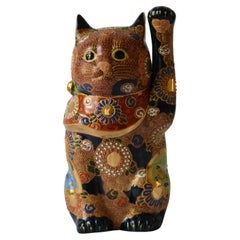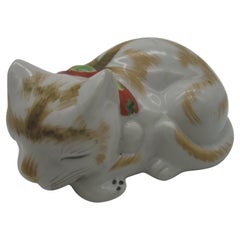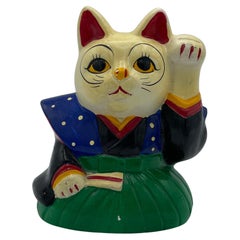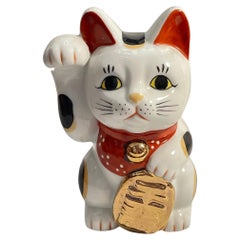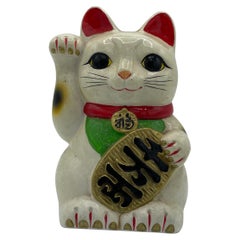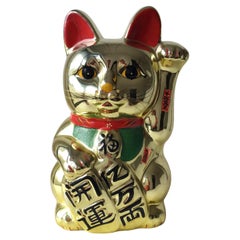Items Similar to Japanese Contemporary Gold Orange Black Red Porcelain Beckoning Cat, 2
Video Loading
Want more images or videos?
Request additional images or videos from the seller
1 of 13
Japanese Contemporary Gold Orange Black Red Porcelain Beckoning Cat, 2
$450
£341.70
€390.75
CA$628.72
A$699.27
CHF 365.14
MX$8,509.36
NOK 4,663.35
SEK 4,373.40
DKK 2,916.35
Shipping
Retrieving quote...The 1stDibs Promise:
Authenticity Guarantee,
Money-Back Guarantee,
24-Hour Cancellation
About the Item
Charming beckoning cat with left paw raised is a gilded and hand painted porcelain piece from the Kutani region of Japan.
Beckoning cats come in two varieties. The more common right-handed beckoning cat (with right paw raised) is said to bring money and wealth to its owner, and are to this day frequently seen in shops and restaurants in Japan. The less common left-handed cat is said to be inviting friends and acquaintances to hearth and home.
While the origins of the Japanese beckoning cat (known as maneki neko in Japanese) are unclear, contemporary woodblock prints show they were being widely sold as good luck charms by the 1850s.
This beckoning cat is adorned with golden medallions and wears a red kerchief with a knotted amulet in the back and two bells on the side. The black and orange and gold patterns set against a pure white background identify this as a Kutani piece, as do the perked ears turned outward.
Dimensions: H 8.5 in W 5 in
- Dimensions:Height: 8.5 in (21.59 cm)Diameter: 5 in (12.7 cm)
- Style:Meiji (In the Style Of)
- Materials and Techniques:
- Place of Origin:
- Period:
- Date of Manufacture:Contemporary
- Production Type:New & Custom(One of a Kind)
- Estimated Production Time:Available Now
- Condition:
- Seller Location:Takarazuka, JP
- Reference Number:Seller: CSTY CVZM1stDibs: LU2771338573582
About the Seller
5.0
Vetted Professional Seller
Every seller passes strict standards for authenticity and reliability
Established in 2009
1stDibs seller since 2017
231 sales on 1stDibs
- ShippingRetrieving quote...Shipping from: Takarazuka, Japan
- Return Policy
Authenticity Guarantee
In the unlikely event there’s an issue with an item’s authenticity, contact us within 1 year for a full refund. DetailsMoney-Back Guarantee
If your item is not as described, is damaged in transit, or does not arrive, contact us within 7 days for a full refund. Details24-Hour Cancellation
You have a 24-hour grace period in which to reconsider your purchase, with no questions asked.Vetted Professional Sellers
Our world-class sellers must adhere to strict standards for service and quality, maintaining the integrity of our listings.Price-Match Guarantee
If you find that a seller listed the same item for a lower price elsewhere, we’ll match it.Trusted Global Delivery
Our best-in-class carrier network provides specialized shipping options worldwide, including custom delivery.More From This Seller
View AllJapanese Contemporary Gold Orange Black Red Hand painted Porcelain Beckoning Cat
Located in Takarazuka, JP
Charming beckoning cat with left paw raised is a gilded and hand painted porcelain piece from the Kutani region of Japan.
The beckoning cat comes in two varieties. The more common right-handed beckoning cat (with right paw raised) is said to bring money and wealth to its owner, and are to this day frequently seen in shops and restaurants in Japan. The less common left-handed cat is said to be inviting friends and acquaintances to hearth and home.
While the origins of the Japanese beckoning cat (known as maneki neko (in Japanese) are unclear, contemporary woodblock...
Category
21st Century and Contemporary Japanese Meiji Animal Sculptures
Materials
Gold
Japanese Contemporary Gold Orange Blue Green Porcelain Lucky Cat Sculpture
Located in Takarazuka, JP
Japanese Contemporary porcelain beckoning cat, a uniquely and intricately gilded and hand painted porcelain piece from the Kutani region of Japan. The cat raising his left paw is adorned with multiple golden medallions and is covered with raised loops characteristic of the Kutani “mori” style. While the origins of the Japanese beckoning cat are unclear, contemporary woodblock...
Category
21st Century and Contemporary Japanese Meiji Animal Sculptures
Materials
Gold
Japanese Contemporary Red Blue Green Gold Porcelain Lucky Cat Sculpture, 2
Located in Takarazuka, JP
Exquisite Japanese Contemporary porcelain beckoning cat, a uniquely and intricately gilded and hand painted porcelain sculpture from the Kutani region of Japan. The cat raising his left paw is adorned with multiple golden medallions and is covered with raised loops characteristic of the Kutani “mori” style. While the origins of the Japanese beckoning cat are unclear, contemporary woodblock prints show they were being widely sold as good luck charms by the 1850s. The beckoning cat comes in two varieties. The more common right-handed beckoning cat (with right paw raised) is said to bring money and wealth to its owner, and are to this day frequently seen in shops and restaurants in Japan. The less common left-handed cat is said to be inviting friends and acquaintances to hearth and home.
The “mori” style refers to raised loops and other decorative motifs applied by squeezing a tube of slip onto the body of the cat much like applying frosting to a cake.
The cat boasts the traditional Kutani colors of bright green, red and yellow presented against an dark blue background, and is generously accentuated with gold. The red kerchief with a knotted amulet in the back and two bells on the side also identify this as a traditional Kutani piece, as do the perked ears turned outward.
A stamp indicating it is produced in Kutani region of Japan appears at reverse side of this beckoning cat scultures...
Category
21st Century and Contemporary Japanese Meiji Animal Sculptures
Materials
Gold
Japanese Meiji Period Gold White Porcelain Sleeping Cat Sculpture, circa 1910
Located in Takarazuka, JP
Exquisite Meiji period Japanese Kutani sculpture of a sleeping cat in fine porcelain, inspired by the small wooden sculpture at the entrance of...
Category
Early 20th Century Japanese Meiji Animal Sculptures
Materials
Gold
Japanese Gold Red Porcelain Vase by Contemporary Master Artist
Located in Takarazuka, JP
Exquisite contemporary Japanese hand painted decorative porcelain vase, a signed piece by highly respected award-winning Japanese master porcelain artist in the Imari-Arita style. In...
Category
21st Century and Contemporary Japanese Vases
Materials
Gold
$3,815 Sale Price
30% Off
Japanese Contemporary Gold Black Platinum Porcelain Vase by Master Artist, 4
Located in Takarazuka, JP
Japanese contemporary Japanese decorative porcelain vase, hand painted in platinum and gold, set against a dimpled black background, a signed piece belonging to the signature fish co...
Category
21st Century and Contemporary Japanese Meiji Ceramics
Materials
Gold, Platinum
$556 Sale Price
20% Off
You May Also Like
Japanese Vintage Manekineko Cat Object 1970s
Located in Paris, FR
This is a vintage piggy bank of manekineko cat. It is made with pottery and it was made around 1970s in Showa era.
DImensions.
10 x 6.5 x H12.5 cm
The maneki-neko is a common Japa...
Category
Vintage 1970s Japanese Showa Antiquities
Materials
Pottery
Japanese Fortune Manekineko Lucky Cat Object 1980s Showa
Located in Paris, FR
This is a manekineko cat object. It is made with porcelain and it was made around 1980s in Showa era.
Dimensions.
8 x 8.5 x H13 cm
The maneki-neko is a common Japanese figurine ...
Category
Vintage 1980s Japanese Showa Animal Sculptures
Materials
Porcelain
Japanese Antique Pottery Manekineko Rocking Cat Object 1970s
Located in Paris, FR
This is a vintage piggy bank of manekineko cat. It is made with pottery and it was made around 1970s in Showa era. This cat is rocking object, it is rare than the other manekineko ca...
Category
Vintage 1970s Japanese Showa Antiquities
Materials
Pottery
1980s Japanese Large Retro Golden Maneki Neko Beckoning Cat Coin Bank
Located in Chiba, JP
Large type retro ceramic ‘Maneki-neko’ coin bank, 1980s, Japan, approx. H 40 x W 24 x D 20 cm (15.74 x 9.44 x 7.87in). in rare very fine storage condition with just some expected sli...
Category
Vintage 1980s Japanese Japonisme Ceramics
Materials
Ceramic
Japanese Hand Painted Ceramic Cat Sculpture
Located in Douglas Manor, NY
3-726 vintage Japanese hand painted ceramic cat sculpture
Category
Vintage 1950s Japanese Ceramics
Materials
Ceramic
$375 Sale Price
61% Off
Staffordshire Cat Figure, Circa 1970
Located in High Point, NC
Circa 1970 vintage figure of a cat from the Staffordshire region of England. The cat is decorated in black and white, and has a gold bow around its neck. This is a nice model, as i...
Category
Vintage 1970s English Animal Sculptures
Materials
Ceramic
More Ways To Browse
Good Luck Charms
Japanese Cat
Cat Charm Gold
Japan Bell
Porcelain Cat Sculpture
Japanese White Porcelain Sculptures
Kutani Gold
Porcelain White Cat
Good Luck Amulet
Meiji Cat
Cat Sculpture Japan
Japanese Beckoning Cat
Beckoning Cat
Kutani Cat
Maneki Neko
Resting Horse Sculpture
Horse Sculpture Marble Base
Pelican Objects
